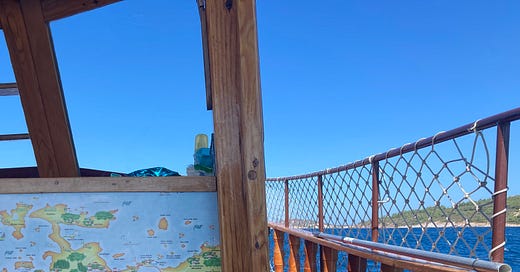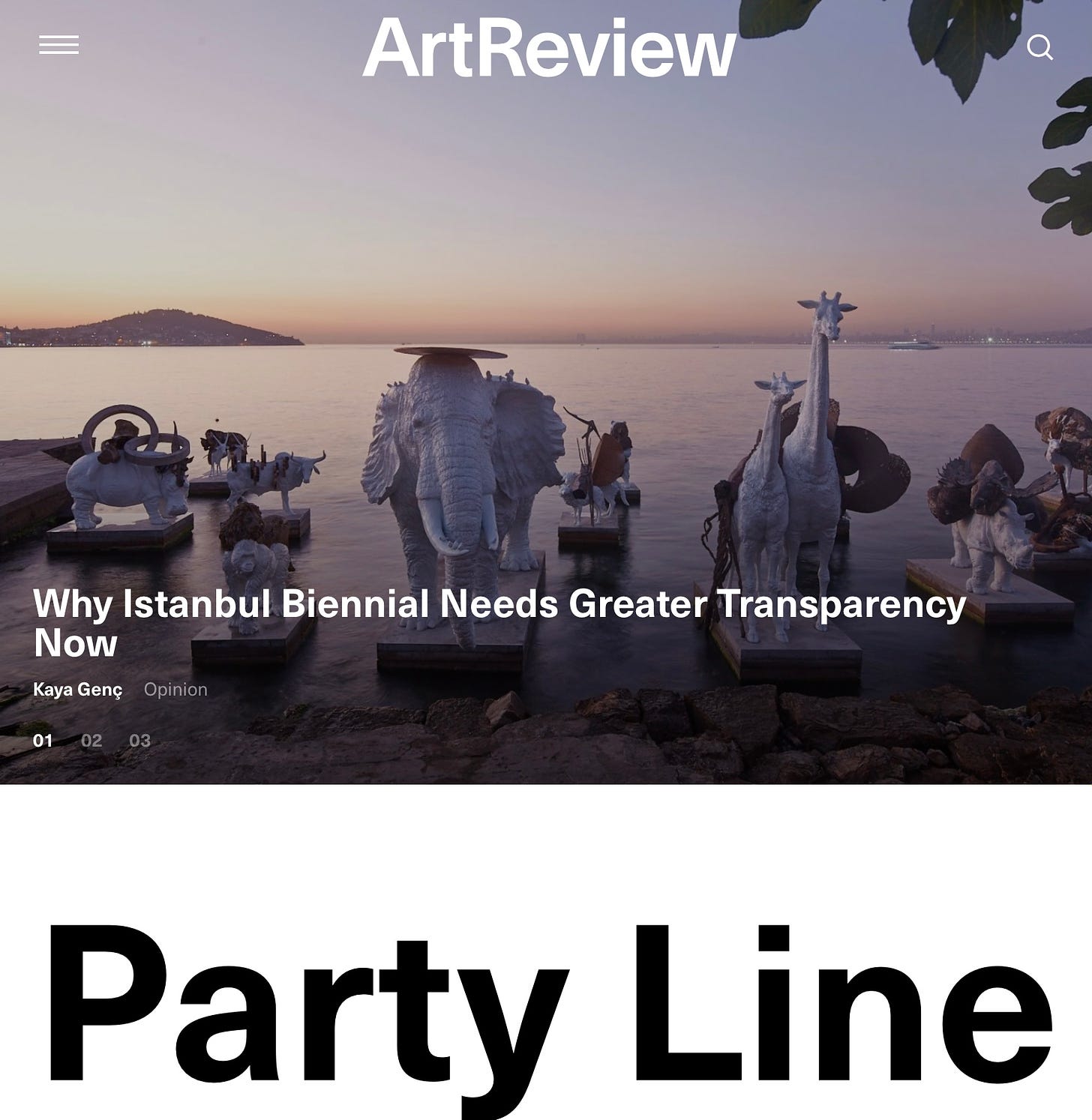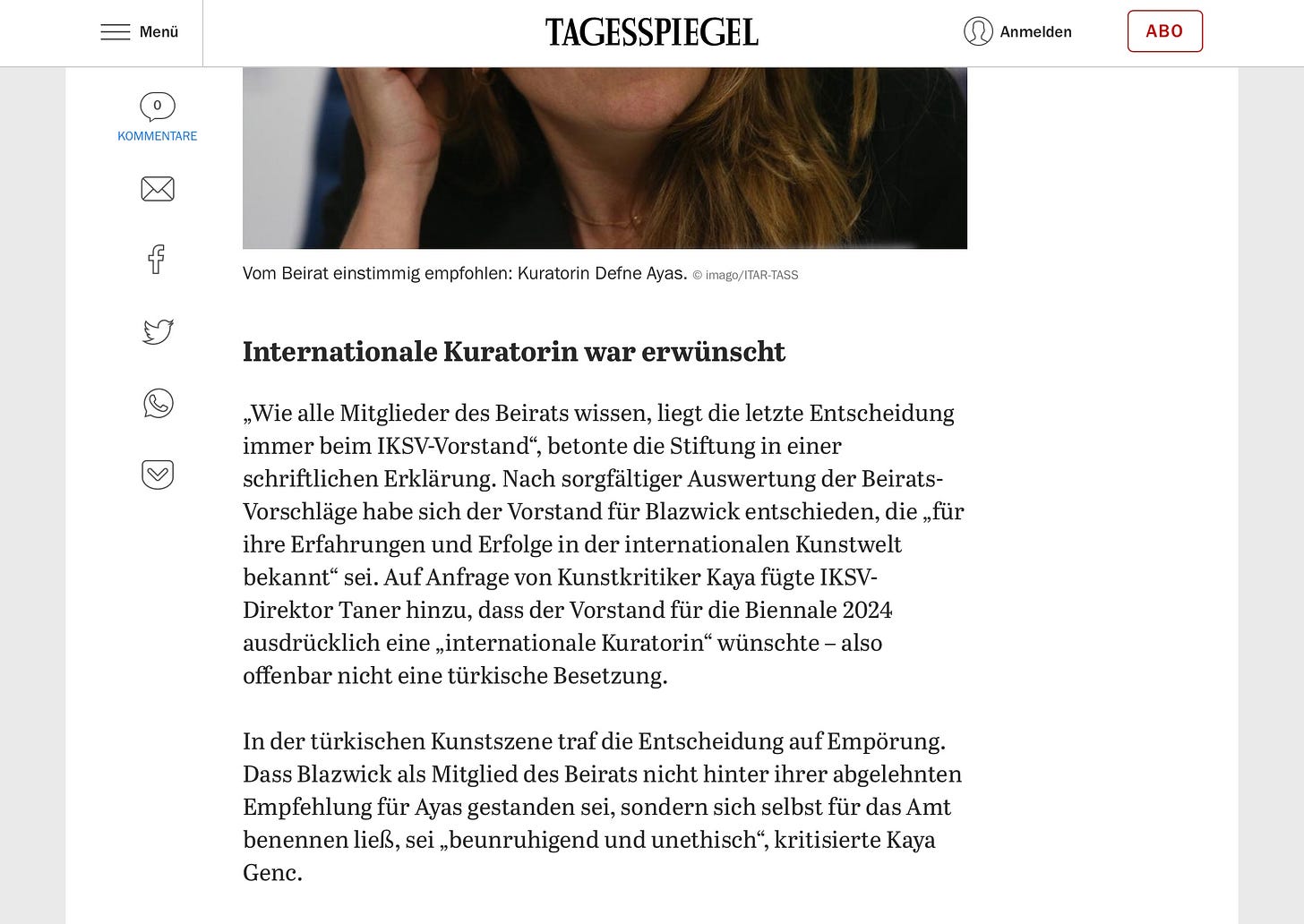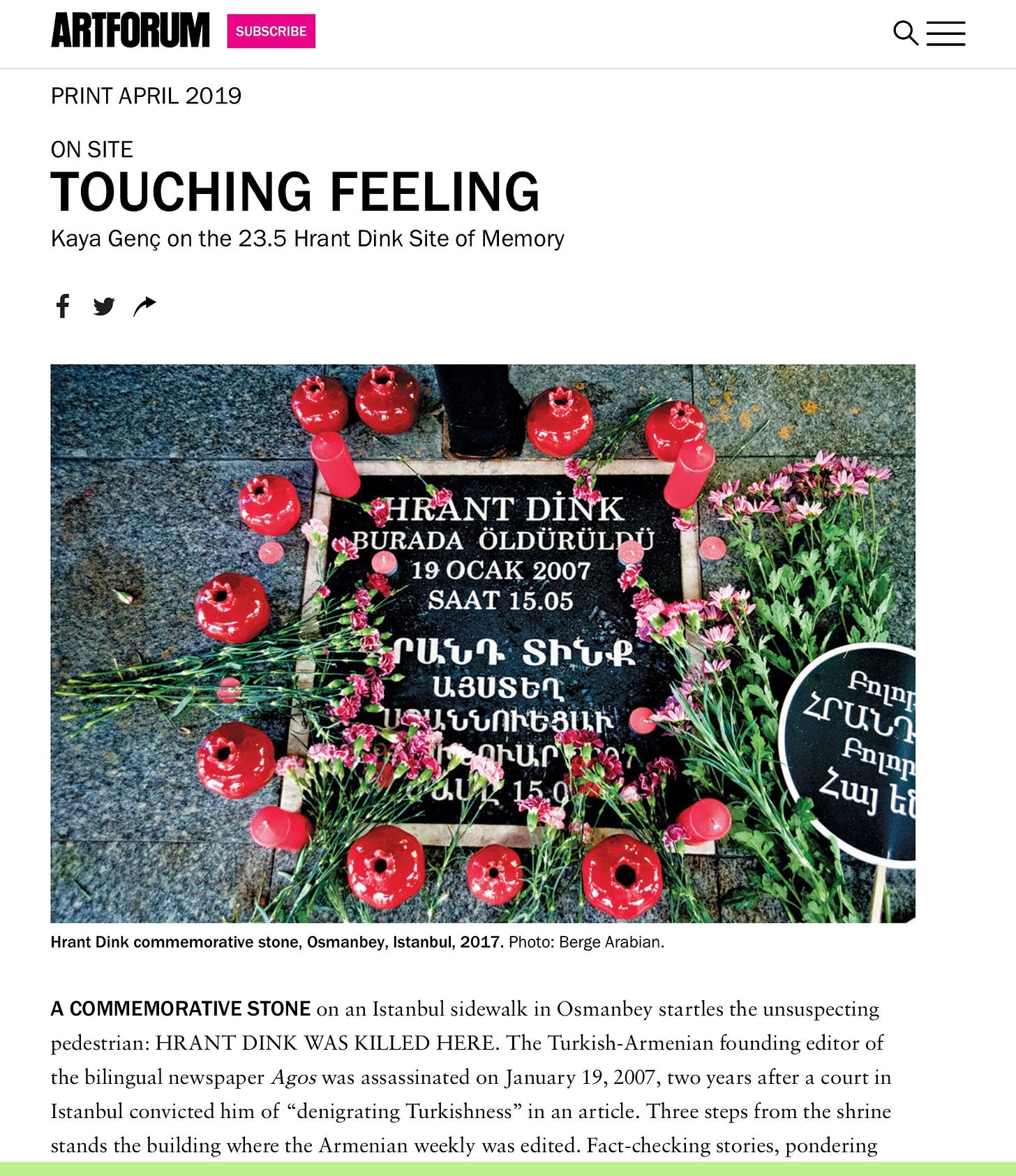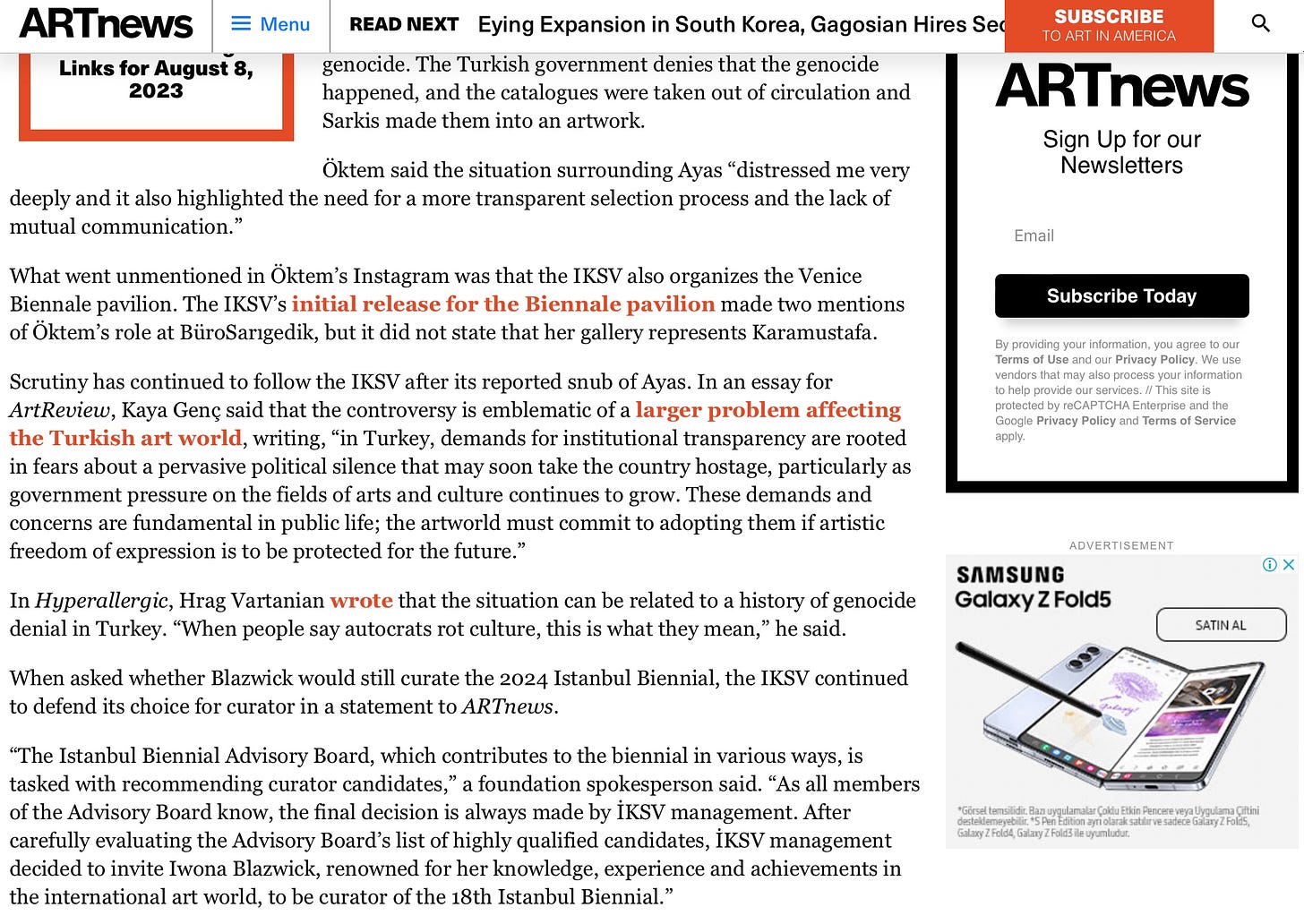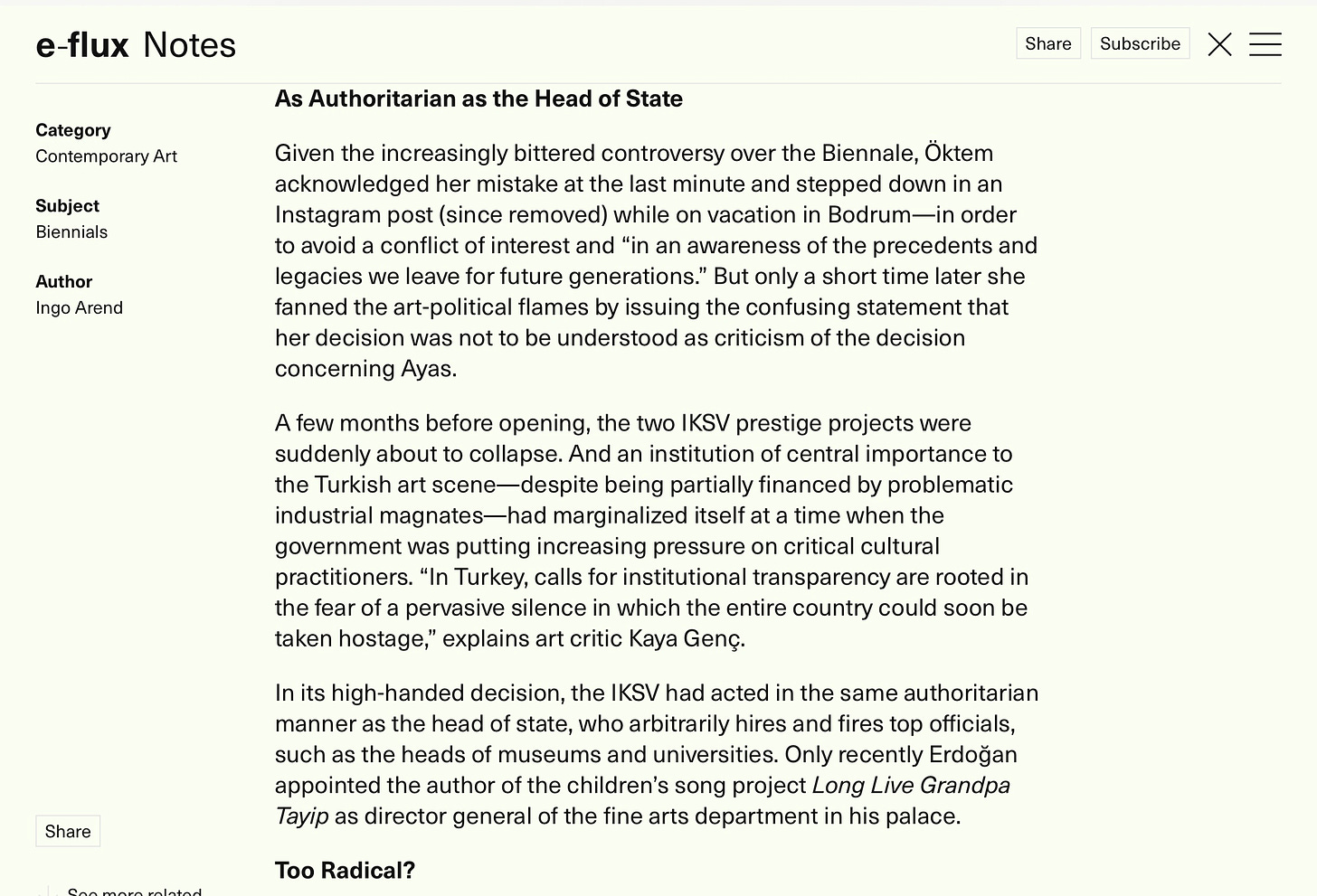How we broke the Istanbul Biennial story
This summer, I came across a story about the upcoming edition of the Istanbul Biennial that was unnerving to tell but too good to pass
A few days before posting my latest Substack about the latest assault on Turkey’s art world (“Istanbul Modern and Its Discontents”) on August 3, I heard a distressing story about one of that world’s leading symbols: the Istanbul Biennial.
Onboard the ship where I learned details about the Istanbul Biennial story.
I was holidaying in Ayvalık, appreciating that old Greek town from the sea, in the course of a nocturnal boat trip. As we sipped wine and looked at the stars, someone asked whether I knew about what happened during the selection process of the Istanbul Biennial’s 2024 edition.
Defne Ayas, the former director of Witte de With Center for Contemporary Art in Rotterdam, was originally picked to curate next year’s biennial in January. But then, because of an unexplained development, İKSV took that role away from her.
An e-mail, written after the Board meeting, notified Ayas that, well, she wouldn’t be curating the 2024 Istanbul Biennial after all. Wasn’t that shocking, the person asked.
It was. I recall the feeling of dread as I looked at the surrounding islands. Surely there was something wrong with their version of events. The Istanbul Foundation of Culture and Arts (İKSV) would never allow such a thing to happen.
But I also knew that Turkish born intellectuals, authors and artists with an international stature like Ayas could easily be blackballed in Recep Tayyip Erdoğan’s autocratic New Turkey. The Turkish government despises freethinkers like Ayas and devotes a lot of time to disenfranchising, imprisoning, and demonizing them.
Days after the boat trip, I joined a Transparency Initiative, formed by a small group of curators, artists and cultural scholars. Meeting on Zoom, we tried to piece together the story.
Who exactly had picked Ayas? What had she proposed for the new edition? Who were on that Advisory Board that picked her project? Who objected to her selection?
I learned, during those talks, that Iwona Blazwick, the former director of Whitechapel Art Gallery, was appointed as the new curator and that this would be announced in the coming days.
We formed a WhatsApp group and on August 1, İKSV indeed announced Blazwick as the curator of the 2024 Istanbul Biennial. Yet the announcement didn’t contain the names of Advisory Board members. Neither was there any mention of Defne Ayas, and her rejected proposal.
On August 11, ArtReview published my essay on its frontpage.
This was odd. Yet the art press in Turkey seemed uninterested in questioning why the press release didn’t list the names of Advisory Board members. Instead, photographs of Blazwick and her biography adorned short news articles.
In a Zoom meeting with the Transparency Initiative a few days later, I learned that Selen Ansen, an Advisory Board member, had resigned before the announcement. There were others who also left the Board.
Something had happened that nobody dared talk about.
Through personal connections, we started reaching out to Board members, trying desperately to extract details. Soon, through a flurry of Instagram direct messages, e-mails, and phone call transcripts, a distressing picture, much worse than the initial version of the story, emerged.
Board members had unanimously picked Ayas as the curator of the new edition and then resigned in protest, when İKSV refused to appoint Ayas as the new curator.
On August 28, Tagesspiegel covered the story for German readers.
There were creases in the story that needed ironing: who had resigned first, citing which reasons? Had all Board members followed that person? Was Blazwick really, as I feared, a member of the Board that picked Ayas?
Over a frantic week, I learned that İKSV had indeed dismissed the Board and appointed Blazwick as a placeholder. (Almost a month has passed since we broke this story, and Blazwick who seems Zen about the whole thing, has kept her silence.)
That night, I suffered heart palpitations: what if my story was wrong? I emailed all the Board Members to give them a chance to respond and I began collecting all the responses in a separate document. I got in touch with Defne Ayas and learned about her side of the story.
My suspicion of censorship was rooted in the research I’ve made while writing this 2019 essay for Artforum.
Then I remembered something else. In 2019, I had the good fortune to write a long essay on the opening of the 23.5 Hrant Dink Site of Memory in Istanbul for Artforum. During my research for that piece, I learned that while the Turkish-Armenian artist Sarkis installed a work in the Turkish Pavilion at the 2015 Venice Biennial, Turkish officials objected to the distribution of an accompanying booklet produced for the exhibition. Ayas had curated the Turkish Pavilion that year.
The next morning, I put my version of events to İKSV whose great press team sent back the responses in a matter of hours. Now I was able to include the rationale of the İKSV in my piece too.
With a heavy heart, I filed my piece.
Meanwhile I learned that another writer was chasing the story as well. As we prepared to publish the piece on ArtReview, Cristina Ruiz broke the story on The Art Newspaper. Her well-researched and thorough article confirmed all the details I’ve placed in my essay which was published some hours later.
The reaction to our two articles was spectacular.
The coverage of ArtNews, published on August 15.
From ArtNews, Artforum and e-flux in New York to Tagesspiegel and Monopol: Magazin für Kunst un Leben in Berlin and Artribune in Rome, Turkey-watchers expressed shock and dismay. There were articles in numerous other languages, including an essay by Şener Özmen in Kurdish.
A flurry of new resignations followed the international coverage of our articles.
On August 14, Esra Sarıgedik Öktem, curator of the Turkish Pavilion at the forthcoming Sixtieth Venice Biennale, resigned from her post. In an Instagram post she wrote that the İKSV’s treatment of Ayas had “distressed [her] deeply” and “highlighted the need for a more transparent selection process and the lack of mutual communication.”
On August 28, Istanbul Modern announced that Levent Çalıkoğlu, its chief curator of since 2012, had resigned. We don’t know why yet, but my previous coverage may offer some clues.
On August 29, e-flux published an essay about the debate.
Among numerous articles published in Turkish, some refused to acknowledge the political aspects of the story, while one even called us “traitors”. But others shared the frustration of the Transparency Initiative. Cansu Çamlıbel, Çağdaş Ertuna and Özlem Altunok published terrific interviews, articles and op-eds that enriched our understanding of the scandal. Still, editors and critics who work in Istanbul expressed sadness that a Turkish language publication couldn’t break the story. Publishers and readers pondered the funding system of Turkish journalism, discussing new ways to pay critics and investigative journalists to break stories like ours.
Such is the outcome of increasingly totalitarian regimes where the truth disappears, for months (six months, in the Biennial’s case), before someone learns about a story on a boat trip.
Until next time,
—Kaya

